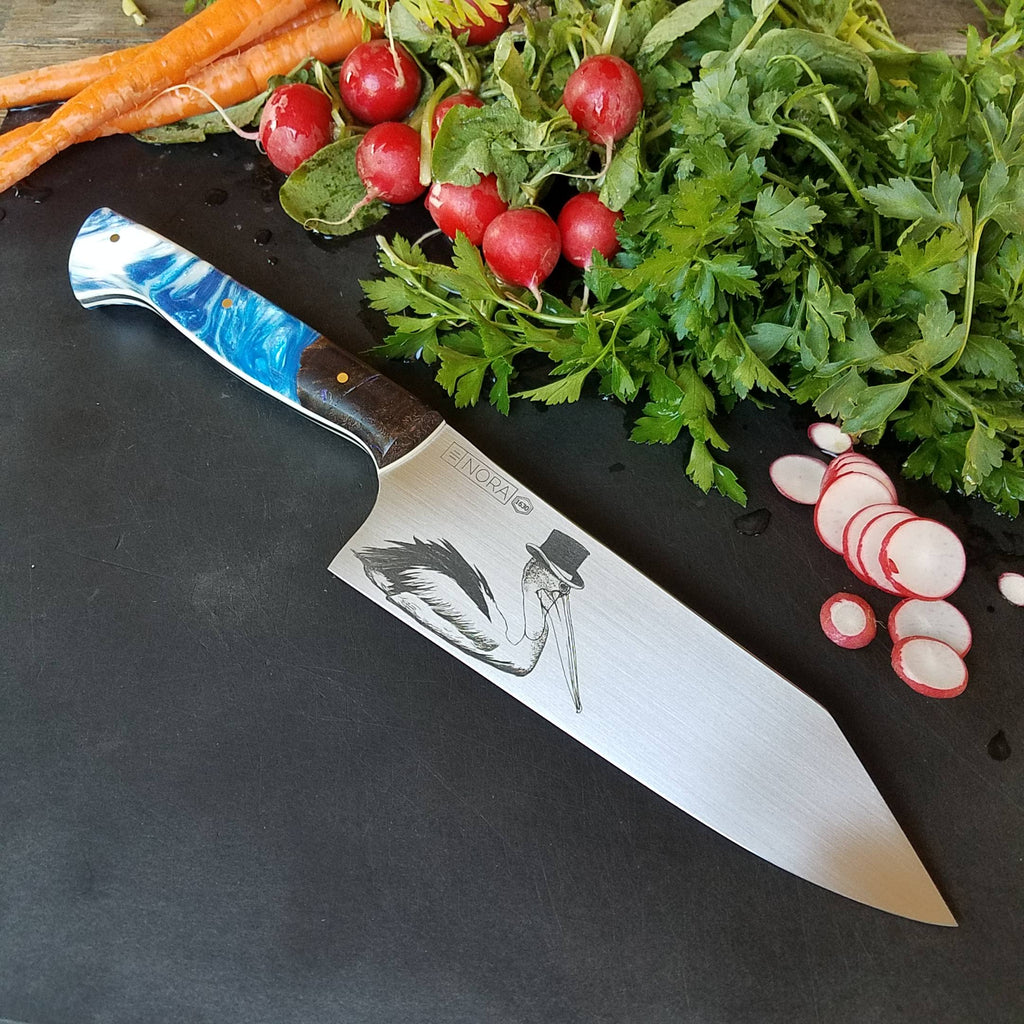
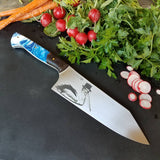
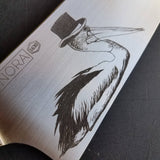
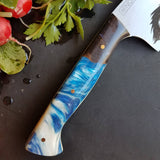
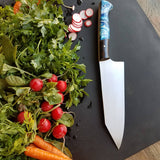
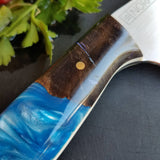
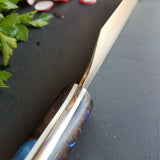
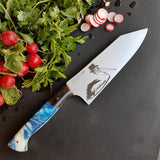
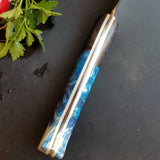
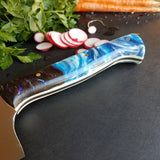
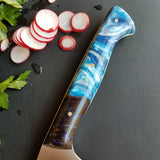
NORA #1630 - 7.5 Kiritsuke - Tuppence a Bag
$ 359.00
KNIFE HIGHLIGHTS
- Blade Type: Kiritsuke
- Blade Length: 7.5 Inches
- Total Length: 12.5 Inches
- Handle Style: Western | Right or Left Hand Use
- Steel: AEB-L Stainless Steel
- Handle Materials: Live Edge Walnut Burl Wood paired with urethane based resins, ivory G10 liners, brass pins
- Rockwell Hardness: 62 HRC
- Grind Type: Full Flat
- This Blade is Ground...
- Thin for Performance (Best performance, but delicate)
- Thick for Durability (tough, built to last for heavy wear-n-tear)
- >>> Mid-Range with Special Geometry (specially ground for food release and glide but blade is kept slightly thicker for durability)
- This Knife Feels...
- Heavy in Hand (hefty, durable)
- Light (nimble, maneuverable)
- >>>Not too heavy, not too light (Switzerland)
GENERAL USES OF THIS KNIFE
KIRITSUKE KNIFE:
This blade design is our take on the traditional Japanese Kiritsuke knife.
A Kiritsuke knife is one of the very few Japanese knives that is considered multi-purpose. It is a hybrid between a Yanagi (fish slicer) and a Usuba (vegetable knife.). A Kiritsuke knife works well for slicing and breaking down protein but it also excels at vegetable prep. and general purpose tasks. In Japanese kitchens, the Kiritsuke knife is reserved only for the executive Chef as a sign of respect and also due to the skill needed to efficiently use these knives.
Our Kiritsuke design does not have as flat of a belly as the more traditional Japanese style knives. We have done this to allow just the slightest amount of rock in the cut. We feel it adds a bit more versatility to the knife.
ENGRAVING:
This proper gent was just calling to be placed on a knife. (In a most dignified manner, of course) When I saw this image, I couldn't help but think of the Mary Poppins movie. Immediately I went to the scene where the woman was feeding the birds. Instead of begging, flocking birds though I imagined a world where this fellow would approach the woman and hand her his tuppence (two-pence) in exchange for his morning breakfast on the way to work. The exchange would be brief and familiar. He would tip his cap, wish her a good day and then head to the dock. Not unlike the gentleman who purchases his paper from the local newsboy each day. Why this belongs on a knife, I know not. I just thought I would add to the pot of random weird things in this world.
General Notes: This knife has been custom engraved. The engraving was done via fiber laser so there is depth to the engraving more so than you generally see with an electro etch or CO2 laser. We do, however, keep the depth low so it does not catch food and minimally interferes with the primary cutting function of the knife. A small amount of stickage is normal around the engraved area, especially initially. (due to a very small burr that is formed around the engraved area) This will lessen over time as the blade is used. The engraving should last as long as the knife but please note that it will slightly degrade over time as abrasives are used on the knife. We recommend the soft end of a sponge with soap and water for cleaning and mineral oil periodically to condition the blade (and handle). Keep in mind that stronger abrasives, such as steel wool, scotch brite pads, sand paper or stone sharpening directly on the engraved image will further degrade the image.
HANDLE DESIGN & MATERIALS:
Every one of our knives is handmade, numbered and unique. The number on each knife represents the production order of our small company. As such, if you have NORA #1000 (near our logo), that knife represents the 1,000th knife made here at NORA knives.
This NORA knife has been handled with a Glacial Blue 'Shokwood' handle which has hues of deep sky blue and shimmering white in the resin. Shokwood is a hybrid mix of stabilized live edge wood and urethane based resins. This particular handle has a very dark piece of stabilized American walnut burl wood.
The nice thing about these handles is that this is wood that is usually thrown out by the mills since it is deemed unusable for most uses. It gets new life on this knife after being stabilized and with the resin added.
Wood stabilization is an added feature that we offer with our knives. Wood that is stabilized has been injected with a clear acrylic resin under a vacuum process. Stabilization helps to minimize, if not eliminate, any cracking, warping, shrinkage and/or expanding of the material. Stabilized wood will not absorb water and is generally impervious to oils. The process helps to ensure your knife has a long lifespan in the kitchen.
STEEL INFORMATION:
AEB-L STAINLESS STEEL
This knife blade is composed of AEB-L stainless steel which is a high-quality Swedish metal, originally developed for razor blades. Recently, steel suppliers have made this steel available in thicker sheets and it has proven to be an excellent adaptation for the cutlery industry.
AEB-L has a beautiful balance of carbon and chromium and, with proper heat treatment, this steel produces both a very fine edge as well as excellent toughness and edge stability. The fine grain structure also makes this steel very easy to sharpen. We believe it is one of the finest stainless steels available on the market today for use with kitchen knives.
As a side note, there are two things we like to mention about this steel:
1.) This steel responds beautifully to honing and if the knife is honed regularly it should need infrequent sharpening.
2.) AEB-L is a stainless steel but just barely. The higher carbon content in this stainless is what allows it to get a fine edge and higher hardness than other stainless steels but it also has a tendency to sometimes form very fine rust spots on the blade. If this happens, these are easily removed with a green scotch brite pad and usually the rough end of a kitchen sponge will also do the trick.
